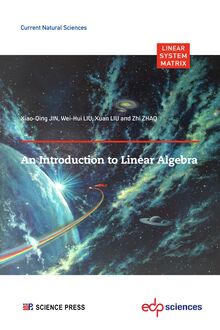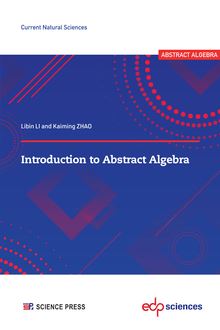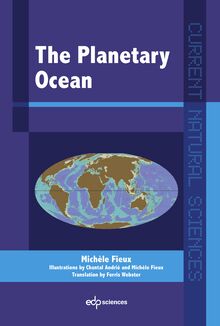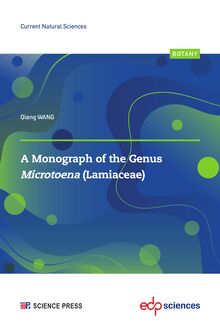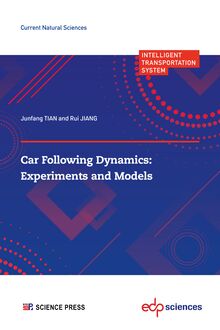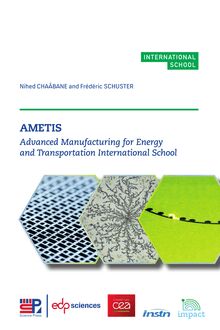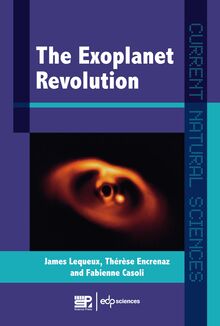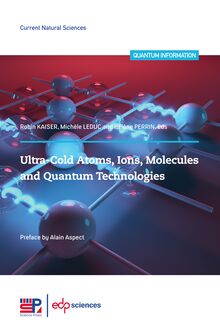Atomic Clusters , livre ebook
416
pages
English
Ebooks
2024
Obtenez un accès à la bibliothèque pour le consulter en ligne En savoir plus
Découvre YouScribe en t'inscrivant gratuitement
Découvre YouScribe en t'inscrivant gratuitement
416
pages
English
Ebooks
2024
Obtenez un accès à la bibliothèque pour le consulter en ligne En savoir plus
Publié par
Date de parution
20 juin 2024
Nombre de lectures
3
EAN13
9782759834587
Langue
English
Poids de l'ouvrage
47 Mo
The spectacular development of nanotechnologies over the last twenty years has introduced all kinds of nano-objects or nanoparticles into everyday life. The remarkable properties of these nano-materials explain why they are used as much in cosmetics and lubricants as in most high-tech components.
The aim of this book is to describe the basic principles governing nanoscience, and nanophysics in particular. The authors show how the physics and chemistry of atoms influence the properties of nano-objects. They also describe how the properties of macroscopic materials are modified when their size decreases.
This first volume is devoted to aggregates or nanoparticles in the ground state. It shows how binding energy and symetry properties govern the arrangement of atoms according to their electronic structure. It also explains the influence of metal bond complexity on the properties of transition metal nanoparticles. Applications are given for insulator-metal transition, magnetism and catalysis.
A second volume will describe the influence of the temperature, the excited states of aggregates and their optical properties. The authors come from different backgrounds, Michel Broyer from atomic and molecular physics and Patrice Mélinon from condensed matter. They were both pioneers in aggregate and work at Lyon I University.
1 Introduction 1
1.1 Cluster physics: a young science . . . . . . . . . . . . . . . . . . 1
1.2 Size effect, role of the surface . . . . . . . . . . . . . . . . . . . 3
1.2.1 Geometrical consideration . . . . . . . . . . . . . . . . 3
1.2.2 Generalization . . . . . . . . . . . . . . . . . . . . . . . 4
1.3 Kubo conductivity criterion for metallic clusters . . . . . . . . 4
1.4 Examples of some of the more specific remarkable size effects . . . . . . . . . . . . . . . . . . . . . . . . . . . . . . 5
1.4.1 The discovery of carbon fullerenes . . . . . . . . . . . . 5
1.4.2 Metal insulator transition in clusters of specific systems . . . . . . . . . . . . . . . . . . . . . . 7
1.4.3 Magnetism . . . . . . . . . . . . . . . . . . . . . . . . . 8
1.4.4 Heterogeneous catalysis . . . . . . . . . . . . . . . . . . 9
1.5 Small disgression on the law in 1/R . . . . . . . . . . . . . . . . 9
1.6 Conclusion . . . . . . . . . . . . . . . . . . . . . . . . . . . . . 10
2 Cohesion of a cluster: origin, chemical bond 11
2.1 Introduction . . . . . . . . . . . . . . . . . . . . . . . . . . . . . 11
2.2 Cohesion of a metallic cluster: case of simple metals . . . . . . . . . . . . . . . . . . . . . . . . . . . . 11
2.2.1 Hamiltonian and cohesive energy in a simple metal . . 12
2.2.2 Jellium model . . . . . . . . . . . . . . . . . . . . . . . 12
2.2.3 Macroscopic approach: liquid drop model . . . . . . . . 14
2.2.4 Tight binding: TBSMA model . . . . . . . . . . . . . . 17
2.2.5 Hückel’s model of quantum chemistry . . . . . . . . . . 23
2.2.6 Realistic model . . . . . . . . . . . . . . . . . . . . . . 27
2.3 Cohesive energy in pure covalent elements . . . . . . . . . . . 29
2.3.1 Introduction . . . . . . . . . . . . . . . . . . . . . . . . 29
2.3.2 Geometry in bulk phase . . . . . . . . . . . . . . . . . . 30
2.3.3 Cohesive energy . . . . . . . . . . . . . . . . . . . . . . 31
2.3.4 Geometry of covalent clusters: some general considerations . . . . . . . . . . . . . . . . . . . . . . . 39
2.3.5 Carbon clusters . . . . . . . . . . . . . . . . . . . . . . 39
2.3.6 Silicon, germanium and tin clusters in sp3 hybridization . . . . . . . . . . . . . . . . . . . . . . . . 51
2.4 Cohesion of ionic systems . . . . . . . . . . . . . . . . . . . . . 54
2.4.1 Introduction . . . . . . . . . . . . . . . . . . . . . . . . 54
2.4.2 Ionic bonding in the bulk phase . . . . . . . . . . . . . 55
2.4.3 Structures of the solid phase . . . . . . . . . . . . . . . 55
2.4.4 Pauling’s rules [Pauling (1929)] . . . . . . . . . . . . . 65
2.4.5 Ionic compounds concerned . . . . . . . . . . . . . . . . 67
2.4.6 Colored centers . . . . . . . . . . . . . . . . . . . . . . 67
2.5 Ionic bonding in clusters . . . . . . . . . . . . . . . . . . . . . . 69
2.5.1 General . . . . . . . . . . . . . . . . . . . . . . . . . . . 69
2.5.2 Colored centers in clusters . . . . . . . . . . . . . . . . 71
2.5.3 Madelung constant in clusters . . . . . . . . . . . . . . 75
2.5.4 Rigid model . . . . . . . . . . . . . . . . . . . . . . . . 75
2.6 Cohesive energy of ionocovalent clusters . . . . . . . . . . . . . 77
2.6.1 Pauling ionicity . . . . . . . . . . . . . . . . . . . . . . 77
2.6.2 Ionicity of Phillips [Phillips and Vechten (1969)] . . . . 78
2.6.3 Phase transition . . . . . . . . . . . . . . . . . . . . . . 79
2.7 Cohesion in van der Waals compounds . . . . . . . . . . . . . . 81
2.7.1 Classical treatment . . . . . . . . . . . . . . . . . . . . 81
2.7.2 Quantum approach . . . . . . . . . . . . . . . . . . . . 82
2.7.3 Van der Waals energy in a cluster . . . . . . . . . . . . 84
3 Shell effects in metallic clusters .....87
3.1 Introduction . . . . . . . . . . . . . . . . . . . . . . . . . . . . . 87
3.2 Experimental results . . . . . . . . . . . . . . . . . . . . . . . . 88
3.2.1 Some anomalies in the mass spectra . . . . . . . . . . . 88
3.2.2 Cohesive energy in clusters: Experimental
methods and results . . . . . . . . . . . . . . . . . . . . 90
3.2.3 Analogy with atoms and nuclei . . . . . . . . . . . . . . 92
3.3 Electronic shells for electronic systems . . . . . . . . . . . . . . 94
3.3.1 Master equation . . . . . . . . . . . . . . . . . . . . . . 95
3.3.2 The model of the hydrogen atom . . . . . . . . . . . . . 95
3.3.3 Case of clusters: choice of V(r) potential . . . . . . . . 96
3.3.4 Deformation of the droplet - Jahn Teller effect . . . . . 116
3.3.5 Calculations with a harmonic potential: Clemenger-Nilsson model . . . . . . . . . . . . . . . . . 118
3.4 Geometric shells . . . . . . . . . . . . . . . . . . . . . . . . . . 118
3.4.1 General remarks . . . . . . . . . . . . . . . . . . . . . . 118
3.4.2 Observation of geometric magic numbers . . . . . . . . 119
3.5 Broken bond model . . . . . . . . . . . . . . . . . . . . . . . . . 120
3.5.1 Binding energy . . . . . . . . . . . . . . . . . . . . . . . 120
3.5.2 Geometric shells . . . . . . . . . . . . . . . . . . . . . . 132
3.5.3 Experimental results . . . . . . . . . . . . . . . . . . . 136
3.6 Other models . . . . . . . . . . . . . . . . . . . . . . . . . . . . 138
3.7 Conclusion . . . . . . . . . . . . . . . . . . . . . . . . . . . . . 138
3.8 Appendix: highlighting the magic numbers . . . . . . . . . . . . 139
4 Insulator metal transition in clusters 141
4.1 Insulator Metal Transition in condensed matter . . . . . . . . . 141
4.1.1 Introduction: from atom to solid, energy bands, definitions . . . . . . . . . . . . . . . . . . . . . . . . . 141
4.1.2 Problem-related to the definition of metal . . . . . . . . 143
4.1.3 Atomic approach of the metallic character: the “catastrophe” of the electric polarizability . . . . . 147
4.1.4 Macroscopic approach by electrical conductivity . . . . 148
4.1.5 Approach in the context of band theory (Mott) . . . . 150
4.1.6 Mott-Hubbard transition in a non mono electronic system . . . . . . . . . . . . . . . . . . . . . . . . . . . 151
4.1.7 Size effect: experimental problems . . . . . . . . . . . . 155
4.2 Insulating Metal Transition in metal clusters . . . . . . . . . . 155
4.2.1 Metal Insulator Transition due to electronic confinement . . . . . . . . . . . . . . . . . . . . . . . . 156
4.2.2 Consideration of degeneracies in the framework of the shell model . . . . . . . . . . . . . . . . . . . . . 157
4.2.3 Experimental results . . . . . . . . . . . . . . . . . . . 161
4.2.4 Insulator-metal transition in divalent metals . . . . . . 167
4.3 Insulator metal transition in semiconductors . . . . . . . . . . . 173
4.3.1 Change of coordination . . . . . . . . . . . . . . . . . . 173
4.4 Electronic confinement in semiconductors . . . . . . . . . . . . 173
4.4.1 Experimental observations . . . . . . . . . . . . . . . . 174
4.4.2 Confinement in a box . . . . . . . . . . . . . . . . . . . 175
4.4.3 Wannier exciton: Efros’s model [Efros and Efros (1982)] 176
4.4.4 More sophisticated models . . . . . . . . . . . . . . . . 177
4.4.5 Clusters of ligand-free semiconductors . . . . . . . . . . 178
4.4.6 Conclusion on semiconductors . . . . . . . . . . . . . . 178
4.5 Overall conclusion . . . . . . . . . . . . . . . . . . . . . . . . . 181
4.6 Appendix . . . . . . . . . . . . . . . . . . . . . . . . . . . . . . 182
4.6.1 Bohr radius aH . . . . . . . . . . . . . . . . . . . . . . . 182
4.6.2 Quantum unit of conductance . . . . . . . . . . . . . . 182
4.6.3 Ioffe Regel criterion [Gurvitch (1981)] . . . . . . . . . . 183
4.6.4 IPES versus PES . . . . . . . . . . . . . . . . . . . . . 184
4.6.5 Mott insulator: an example NiO . . . . . . . . . . . . . 185
5 Complex metals 187
5.1 Introduction . . . . . . . . . . . . . . . . . . . . . . . . . . . . . 187
5.1.1 Atomic structure of metals . . . . . . . . . . . . . . . . 187
5.1.2 Structure of metals and phase diagram in the solid . . 188
5.1.3 Relationship between the structure of the clusters and that of the solid phase . . . . . . . . . . . 190
5.1.4 Fermi surfaces, conductivity, metallicity in solids . . . . 191
5.2 Experimental methods . . . . . . . . . . . . . . . . . . . . . . . 195
5.2.1 Geometric structure . . . . . . . . . . . . . . . . . . . . 195
5.2.2 Cohesive energy: CID . . . . . . . . . . . . . . . . . . . 198
5.3 Alkaline metals, noble metals, reminders of the case of gold . . . . . . . . . . . . . . . . . . . . . . . . . . . 199
5.4 Trivalent metals . . . . . . . . . . . . . . . . . . . . . . . . . . 202
5.4.1 A chameleon metal: the boron . . . . . . . . . . . . . . 203
5.4.2 Aluminum . . . . . . . . . . . . . . . . . . . . . . . . . 204
5.4.3 Gallium . . . . . . . . . . . . . . . . . . . . . . . . . . . 208
5.5 Transition metals . . . . . . . . . . . . . . . . . . . . . . . . . . 210
5.5.1 Ferromagnetism: iron, cobalt, nickel . . . . . . . . . . . 210
5.5.2 A complex transition metal: manganese . . . . . . . . . 210
5.5.3 A simple transition metal: ruthenium . . . . . . . . . . 211
5.5.4 Palladium . . . . . . . . . . . . . . . . . . . . . . . . . 214
5.5.5 Platinum . . . . . . . . . . . . . . . . . . . . . . . . . . 214
5.6 Semi-metals or metalloids . . . . . . . . . . . . . . . . . . . . . 215
5.6.1 Antimony: tetraheral units . . . . . . . . . . . . . . . . 216
5.7 Heavy elements of column IV . . . . . . . . . . . . . . . . . . . 220
5.7.1 Tin . . . . . . . . . . . . . . . . . . . . . . . . . . . . . 220
5.7.2 Lead . . . . . . . . . . . . . . . . . . . . . . . . . . . . 221
5.8 Strongly correlated systems: NiO . . . . . . . . . . . . . . . . . 222
5.9 Lanthanides . . . . . . . . . . . . . . . . . . . . . . . . . . . . . 223
5.10 Conclusion . . . . . . . . . . . . . . . . . . . . . . . . . . . . . 225
6 Dipole and electrical polarizability 227
6.1 Introduction . . . . . . . . . . . . . . . . . . . . . . . . . . . . . 227
6.2 Experimental measurements . . . . . . . . . . . . . . . . . . . . 228
6.2.1 Measurement of the electrical polarizability in the absence of a permanent dipole . . . . . . . . . . . . . . 229
6.2.2 Measurement of the electric dipole . . . . . . . . . . . . 231
6.2.3 Comparison with magnetic measurements . . . . . . . . 234
6.3 The case of atoms . . . . . . . . . . . . . . . . . . . . . . . . . 235
6.3.1 Reminders . . . . . . . . . . . . . . . . . . . . . . . . . 235
6.3.2 Atomic polarizability . . . . . . . . . . . . . . . . . . . 235
6.3.3 Results . . . . . . . . . . . . . . . . . . . . . . . . . . . 239
6.3.4 Evolution of the polarizability as a function of R3at . . . 239
6.4 Alkaline dimers: ellipsoidal jellium . . . . . . . . . . . . . . . . 240
6.5 Metallic clusters . . . . . . . . . . . . . . . . . . . . . . . . . . 243
6.5.1 Cluster electrical dipole . . . . . . . . . . . . . . . . . . 243
6.5.2 Polarizability . . . . . . . . . . . . . . . . . . . . . . . . 245
6.6 Covalent systems . . . . . . . . . . . . . . . . . . . . . . . . . . 249
6.6.1 Carbon clusters . . . . . . . . . . . . . . . . . . . . . . 249
6.6.2 Silicon clusters . . . . . . . . . . . . . . . . . . . . . . . 256
6.7 Ionic compounds . . . . . . . . . . . . . . . . . . . . . . . . . . 259
6.7.1 Small clusters . . . . . . . . . . . . . . . . . . . . . . . 260
6.7.2 Large clusters . . . . . . . . . . . . . . . . . . . . . . . 262
6.7.3 Point charge model . . . . . . . . . . . . . . . . . . . . 263
6.8 Ionocovalent compounds . . . . . . . . . . . . . . . . . . . . . . 263
6.9 Conclusion . . . . . . . . . . . . . . . . . . . . . . . . . . . . . 263
6.10 Appendix . . . . . . . . . . . . . . . . . . . . . . . . . . . . . . 264
6.10.1 Field induced by a dipole . . . . . . . . . . . . . . . . . 265
6.10.2 Thomas Fermi in a system without interaction . . . . . 266
6.10.3 Local electron density . . . . . . . . . . . . . . . . . . . 268
6.10.4 RPA approximation in the Thomas Fermi model . . . . 269
6.10.5 Thomas Fermi in a system with interaction . . . . . . . 271
7 Magnetism 273
7.1 Some definitions . . . . . . . . . . . . . . . . . . . . . . . . . . 273
7.2 Preamble . . . . . . . . . . . . . . . . . . . . . . . . . . . . . . 273
7.3 Atomic and molecular magnetism . . . . . . . . . . . . . . . . . 273
7.3.1 Atomic magnetism . . . . . . . . . . . . . . . . . . . . . 273
7.3.2 Measurement of atomic magnetic moments . . . . . . . 279
7.4 Magnetism in the dimer . . . . . . . . . . . . . . . . . . . . . . 280
7.4.1 Molecular physics approach . . . . . . . . . . . . . . . . 280
7.4.2 Heisenberg’s effective Hamiltonian . . . . . . . . . . . . 282
7.5 Magnetism in n-mers . . . . . . . . . . . . . . . . . . . . . . . . 286
7.6 Magnetism in solid . . . . . . . . . . . . . . . . . . . . . . . . . 286
7.6.1 Origin of ferromagnetism . . . . . . . . . . . . . . . . . 286
7.6.2 Orbital magnetism . . . . . . . . . . . . . . . . . . . . 288
7.6.3 Itinerant magnetism: Stoner criterion . . . . . . . . . . 289
7.7 Weiss Domains . . . . . . . . . . . . . . . . . . . . . . . . . . . 292
7.8 Magnetism in clusters . . . . . . . . . . . . . . . . . . . . . . . 293
7.8.1 Measurement of magnetism in clusters . . . . . . . . . 293
7.8.2 Superparamagnetism . . . . . . . . . . . . . . . . . . . 298
7.8.3 Very small sizes . . . . . . . . . . . . . . . . . . . . . . 299
7.8.4 Intermediate sizes . . . . . . . . . . . . . . . . . . . . . 300
7.8.5 Large sizes: surface effects . . . . . . . . . . . . . . . . 304
7.9 Magnetism in clusters: case of non-ferromagnetics . . . . . . . . . . . . . . . . . . . . . . . . . 307
7.9.1 Free clusters of paramagnetic systems . . . . . . . . . . 307
7.9.2 Supported or clusters with ligands of diamagnetic systems: the case of gold . . . . . . . . . . . . . . . . . 307
7.10 Magnetic susceptibility of small metal clusters in the framework of the Kubo model . . . . . . . . . . . . . . . . . . . . . . . . . 312
7.10.1 Case of bulk metal . . . . . . . . . . . . . . . . . . . . . 312
7.10.2 Case of small monovalent metal clusters . . . . . . . . . 314
7.11 Conclusion . . . . . . . . . . . . . . . . . . . . . . . . . . . . . 314
8 Heterogeneous catalysis 317
8.1 Introduction . . . . . . . . . . . . . . . . . . . . . . . . . . . . . 317
8.2 Gas phase catalysis . . . . . . . . . . . . . . . . . . . . . . . . . 319
8.3 Heterogeneous catalysis . . . . . . . . . . . . . . . . . . . . . . 321
8.3.1 Definition . . . . . . . . . . . . . . . . . . . . . . . . . . 321
8.3.2 Issue . . . . . . . . . . . . . . . . . . . . . . . . . . . . 323
8.3.3 Principle of a laboratory measurement . . . . . . . . . 323
8.4 The 1/R law: a specificity in catalysts . . . . . . . . . . . . . . 325
8.5 Geometric effect . . . . . . . . . . . . . . . . . . . . . . . . . . 325
8.5.1 Coordinance in the bulk phase . . . . . . . . . . . . . . 325
8.5.2 Coordination in large clusters . . . . . . . . . . . . . . 327
8.6 Substrate effect . . . . . . . . . . . . . . . . . . . . . . . . . . . 329
8.6.1 Large clusters . . . . . . . . . . . . . . . . . . . . . . . 329
8.6.2 Small clusters . . . . . . . . . . . . . . . . . . . . . . . 330
8.7 Size effect . . . . . . . . . . . . . . . . . . . . . . . . . . . . . . 331
8.8 Activity and selectivity . . . . . . . . . . . . . . . . . . . . . . . 333
8.9 Cluster morphology: dynamic aspect . . . . . . . . . . . . . . . 334
8.9.1 Dynamics on the surface . . . . . . . . . . . . . . . . . 335
8.9.2 Large clusters: thermodynamic aspect . . . . . . . . . . 336
8.9.3 Small clusters . . . . . . . . . . . . . . . . . . . . . . . 338
8.10 New catalysts: gold . . . . . . . . . . . . . . . . . . . . . . . . . 340
8.10.1 Large clusters . . . . . . . . . . . . . . . . . . . . . . . 340
8.10.2 Small clusters . . . . . . . . . . . . . . . . . . . . . . . 342
8.11 Conclusion . . . . . . . . . . . . . . . . . . . . . . . . . . . . . 342
Conclusion 345
Annex: Ab initio models 347
References 363
Publié par
Date de parution
20 juin 2024
Nombre de lectures
3
EAN13
9782759834587
Langue
English
Poids de l'ouvrage
47 Mo

